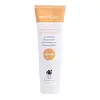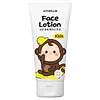What's inside
What's inside
 Key Ingredients
Key Ingredients

 Benefits
Benefits

 Concerns
Concerns

 Ingredients Side-by-side
Ingredients Side-by-side

Water
Skin ConditioningDimethyl Sulfone
SolventPrunus Amygdalus Dulcis Oil
Skin ConditioningCocos Nucifera Oil
MaskingCetearyl Alcohol
EmollientGlyceryl Stearate
EmollientOlea Europaea Fruit Oil
MaskingAloe Barbadensis Leaf Juice
Skin ConditioningSqualane
EmollientPiroctone Olamine
PreservativeGuar Hydroxypropyltrimonium Chloride
Skin ConditioningMel
EmollientAllantoin
Skin ConditioningAcetum
Parfum
MaskingVanilla Planifolia Fruit Extract
Skin ConditioningTocopherol
AntioxidantHumulus Lupulus Extract
AntimicrobialWater, Dimethyl Sulfone, Prunus Amygdalus Dulcis Oil, Cocos Nucifera Oil, Cetearyl Alcohol, Glyceryl Stearate, Olea Europaea Fruit Oil, Aloe Barbadensis Leaf Juice, Squalane, Piroctone Olamine, Guar Hydroxypropyltrimonium Chloride, Mel, Allantoin, Acetum, Parfum, Vanilla Planifolia Fruit Extract, Tocopherol, Humulus Lupulus Extract
Water
Skin ConditioningGlycerin
HumectantCetyl Ethylhexanoate
EmollientPropanediol
SolventMyristoyl/Palmitoyl Oxostearamide/Arachamide Mea
Skin Conditioning1,2-Hexanediol
Skin ConditioningSorbitan Stearate
EmulsifyingCetearyl Alcohol
EmollientGlyceryl Stearate
EmollientStearic Acid
CleansingHelianthus Annuus Seed Oil
EmollientOlea Europaea Fruit Oil
MaskingHydrogenated Vegetable Oil
EmollientPolyglyceryl-10 Distearate
EmulsifyingCocos Nucifera Oil
MaskingVanilla Planifolia Fruit Extract
Skin ConditioningEuphorbia Cerifera Wax
Saccharide Isomerate
HumectantViscum Album Fruit Extract
SoothingBeta-Glucan
Skin ConditioningTriticum Vulgare Sprout Extract
Skin ConditioningBrassica Oleracea Italica Sprout Extract
EmollientPanthenol
Skin ConditioningTocopherol
AntioxidantPhytosterols
Skin ConditioningArginine
MaskingCarbomer
Emulsion StabilisingXanthan Gum
EmulsifyingSodium Phytate
Pelargonium Graveolens Flower Oil
MaskingLavandula Hybrida Oil
EmollientPinus Sylvestris Leaf Oil
MaskingCaprylyl Glycol
EmollientWater, Glycerin, Cetyl Ethylhexanoate, Propanediol, Myristoyl/Palmitoyl Oxostearamide/Arachamide Mea, 1,2-Hexanediol, Sorbitan Stearate, Cetearyl Alcohol, Glyceryl Stearate, Stearic Acid, Helianthus Annuus Seed Oil, Olea Europaea Fruit Oil, Hydrogenated Vegetable Oil, Polyglyceryl-10 Distearate, Cocos Nucifera Oil, Vanilla Planifolia Fruit Extract, Euphorbia Cerifera Wax, Saccharide Isomerate, Viscum Album Fruit Extract, Beta-Glucan, Triticum Vulgare Sprout Extract, Brassica Oleracea Italica Sprout Extract, Panthenol, Tocopherol, Phytosterols, Arginine, Carbomer, Xanthan Gum, Sodium Phytate, Pelargonium Graveolens Flower Oil, Lavandula Hybrida Oil, Pinus Sylvestris Leaf Oil, Caprylyl Glycol
 Reviews
Reviews

Ingredients Explained
These ingredients are found in both products.
Ingredients higher up in an ingredient list are typically present in a larger amount.
Cetearyl alcohol is a mixture of two fatty alcohols: cetyl alcohol and stearyl alcohol. It is mainly used as an emulsifier. Emulsifiers help prevent the separation of oils and products. Due to its composition, it can also be used to thicken a product or help create foam.
Cetearyl alcohol is an emollient. Emollients help soothe and hydrate the skin by trapping moisture.
Studies show Cetearyl alcohol is non-toxic and non-irritating. The FDA allows products labeled "alcohol-free" to have fatty alcohols.
This ingredient is usually derived from plant oils such as palm, vegetable, or coconut oils. There is debate on whether this ingredient will cause acne.
Due to the fatty acid base, this ingredient may not be Malassezia folliculitis safe.
Learn more about Cetearyl AlcoholCocos Nucifera Oil is obtained from the kernels of the coconut fruit. In other words, this is coconut oil.
Coconut Oil is rich in fatty acids with lauric acid making up the majority of these. It also contains linoleic acid. Due to this high fatty acid content, coconut oil helps trap moisture and soften skin.
Despite being antibacterial, coconut oil may not be great for acne-prone skin. It is comedogenic and may clog pores. This ingredient may not be safe for malassezia or fungal acne.
Note: Coconut Oil should not replace your sunscreen for UV protection. Studies show it only blocks about 20% of UV.
This oil is non-volatile and has a light scent.
The term 'fragrance' is not regulated in many countries. In many cases, it is up to the brand to define this term. For instance, many brands choose to label themselves as "fragrance-free" because they are not using synthetic fragrances. However, their products may still contain ingredients such as essential oils that are considered a fragrance.
Learn more about Cocos Nucifera OilGlyceryl Stearate is a mix of glycerin and stearic acid.
It is used to stabilize the mixing of water and oil ingredients. By preventing these ingredients from separating, it can help elongate shelf life. It can also help thicken the product's texture.
As an emollient, it helps soften skin and supports barrier-replenishing ingredients.
In cosmetics, Glyceryl Stearate is often made from vegetable oils or synthetically produced.
This ingredient may not be fungal-acne safe
Fun fact: The human body also creates Glyceryl Stearate naturally.
Learn more about Glyceryl StearateOlea Europaea Fruit Oil is the fixed oil obtained from the ripe fruit of the Olive. In other words - olive oil.
The primary contents of olive oil are glycerides of the fatty acids linoleic, oleic and palmitic.
Olive oil also contains antioxidants such as Vitamin E. Antioxidants may help reduce signs of aging by fighting unstable free-radical molecules. It also contains Vitamins A (retinol), D, and K.
The squalene in olive oil makes it a great emollient. Emollients help soothe and soften your skin by trapping moisture in. This makes olive oil a great skin moisturizer.
Studies show olive oil to have antibacterial and antifungal properties in low concentrations. Another study found olive oil irritated sensitive oily skin. We always recommend speaking with a professional about using this ingredient in your routine.
Due to the fatty acid content, this ingredient may not be fungal-acne safe.
Learn more about Olea Europaea Fruit OilTocopherol (also known as Vitamin E) is a common antioxidant used to help protect the skin from free-radicals and strengthen the skin barrier. It's also fat soluble - this means our skin is great at absorbing it.
Vitamin E also helps keep your natural skin lipids healthy. Your lipid skin barrier naturally consists of lipids, ceramides, and fatty acids. Vitamin E offers extra protection for your skin’s lipid barrier, keeping your skin healthy and nourished.
Another benefit is a bit of UV protection. Vitamin E helps reduce the damage caused by UVB rays. (It should not replace your sunscreen). Combining it with Vitamin C can decrease sunburned cells and hyperpigmentation after UV exposure.
You might have noticed Vitamin E + C often paired together. This is because it is great at stabilizing Vitamin C. Using the two together helps increase the effectiveness of both ingredients.
There are often claims that Vitamin E can reduce/prevent scarring, but these claims haven't been confirmed by scientific research.
Learn more about TocopherolVanilla Planifolia Fruit Extract comes from the vanilla orchid native to central America. It is a skin-soothing ingredient.
This ingredient is skin-soothing and contains polyphenols that give it antioxidant properties.
This ingredient is not known to sensitize or irritate skin (unlike Vanilla Tahitensis). Vanilla tahitensis has shown to irritate skin in low amounts.
Learn more about Vanilla Planifolia Fruit ExtractWater. It's the most common cosmetic ingredient of all. You'll usually see it at the top of ingredient lists, meaning that it makes up the largest part of the product.
So why is it so popular? Water most often acts as a solvent - this means that it helps dissolve other ingredients into the formulation.
You'll also recognize water as that liquid we all need to stay alive. If you see this, drink a glass of water. Stay hydrated!
Learn more about Water